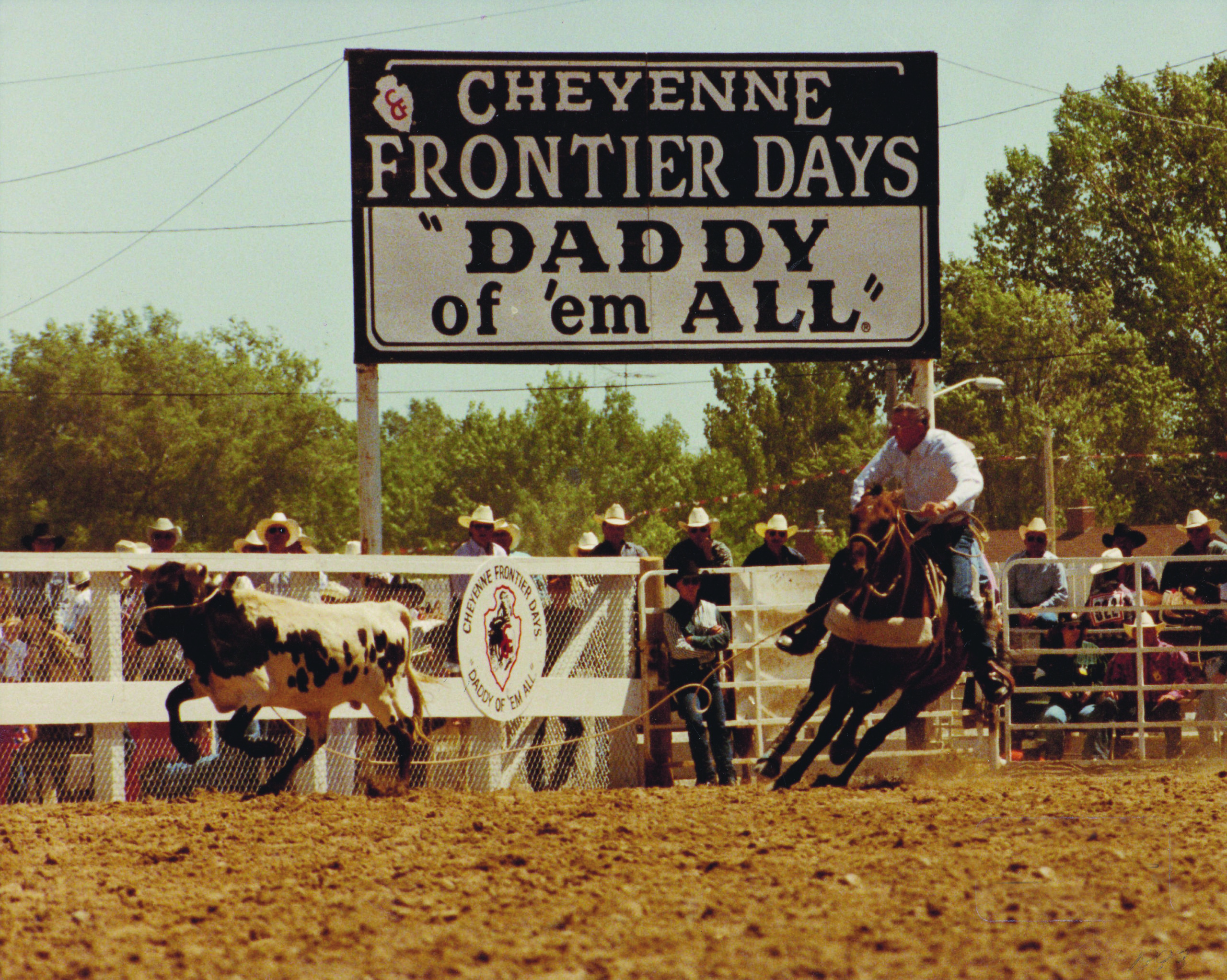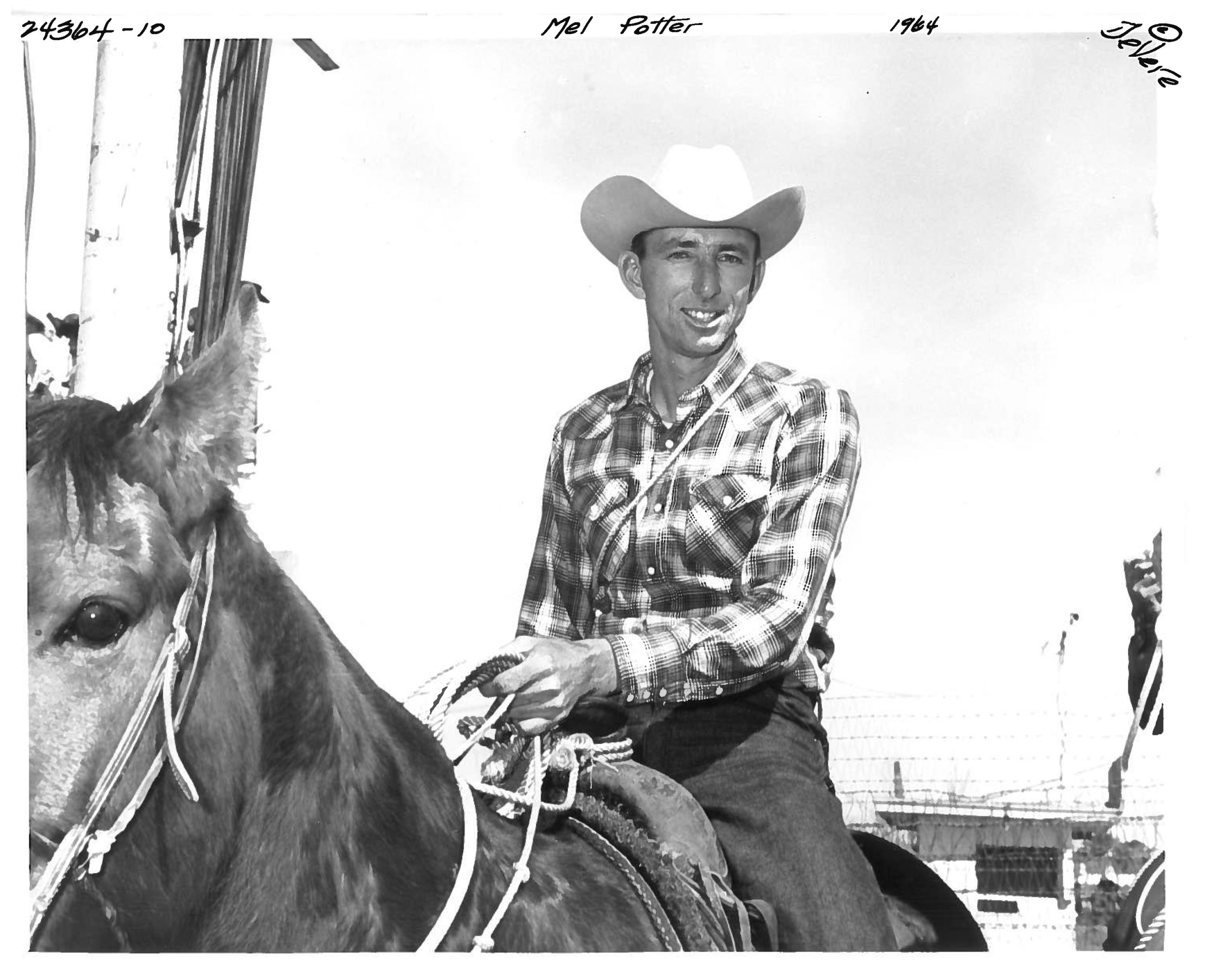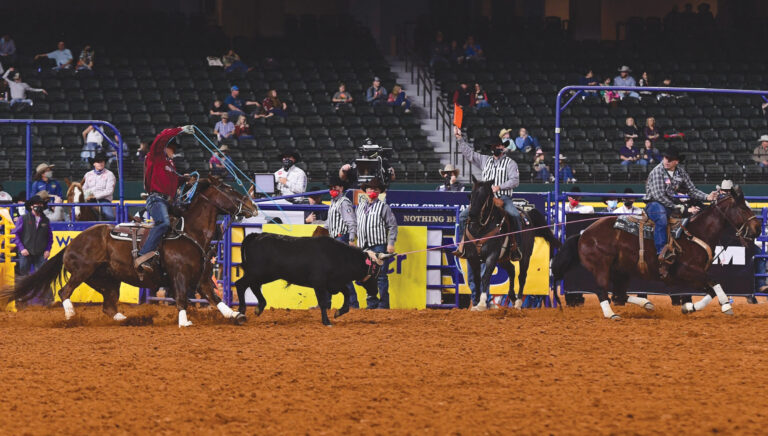Q: Is it true you joined the Rodeo Cowboys Association in 1951, at 16?
A: Yes. Back then, they let you rope at the rodeos until you started winning something. I’d gone to a few, and Fred Darnell—who was the team roping director at the time—rode up to me at the rodeo in Buckeye, Arizona, and said it was time to join. They loved people to donate to the pot, but when you started taking some of the money they wanted you to pay dues.
Q: Your original rodeo specialty was calf roping. In addition to qualifying for the first NFR ever held in 1959, you won such rodeos as Calgary, Denver, and Odessa. When you think back, what stands out to you most now about that first-ever NFR?
A: It wasn’t like it is now. I won the fifth go-round in 14.4, and it paid $434. We roped 400-pound crossbred Brahmas that weren’t like the little goats they rope today. Sonny Davis made the best two-loop run ever made in the history of rodeo in that same round. He was 14.9, and won third in the round.
 Mel Potter on MP Thriftwood
Mel Potter on MP ThriftwoodQ: How tough has it been to split your time between Arizona and Wisconsin over the years?
A: Fortunately, I learned to fly an airplane in 1959, and it allowed me to live two lives. I could take care of my business in Wisconsin, and still make some good rodeos in the West. When I got home from the Finals that year, I had a worn-out station wagon, needed new tires for my horse trailer, and one of my two calf horses was crippled. I knew I needed to learn to raise cranberries. My dad said, “By God, you did learn something in college (at the University of Arizona) besides learning how to rope.” Cranberry season is May 1 to November 1, and it has allowed me to support my expensive roping habit.
Q: When along the way did you take up team roping?
A: Back in those days, there was a lot of team tying in Arizona. You had to get off and tie the knot on the hind feet. We didn’t dally. All the big rodeos in Arizona were team tying.
I had some great heelers—guys like Dale Smith, Eddie Schell, and Cliff Whatley. Eddie and Cliff were left-handed heelers, which was an advantage in the team tying. They roped them as they rode by in the other direction, and I could get down there and tie that knot pretty fast. Cliff and I set the record at Tucson one year right before they quit team tying. We were 10.6 over a 30-foot score. The first time I ever dallied at a rodeo was with (ProRodeo Hall of Fame steer wrestler) Harley May at the rodeo in Clovis, California. We won second.
 Mel Potter wins a round of steer roping at the 1993 Cheyenne Frontier Days.
Mel Potter wins a round of steer roping at the 1993 Cheyenne Frontier Days.Q: Tell me about your roping in more recent times.
A: I was roping right along until last summer. I pulled a groin around the first of August, and the doctor told me to lay off and heal up. Then I went back to roping and pulled a hamstring practicing to go to the World Series Finale in Vegas. The good news is I got back in shape and roped there in December. The bad news is I didn’t win anything. I went to two World Series ropings in Arizona this last winter, but I have an artificial right shoulder, and I’m just miserable the next day. I started roping when I was 13, so maybe 70 years of roping is enough. I hate it, but that’s the way it is.
Q: Your horse program is legendary. Which horse is your all-time favorite?
A: The most famous is that little mare of Sherry’s, Stingray. Her sire, Dinero, is the best horse I ever bought. He’s raised a whole bunch of them, including Hailey Kinsel’s palomino mare, Sister. Dinero’s had 18 horses go to the Finals in three events—barrel racing, team roping, and steer wrestling. Sherry and Cory (Petska, the reigning world champion heeler and Sherry’s husband) won $400,000 on Dinero.
Q: What are the most important traits in a good one for any timed event?
A: That they have some Driftwood blood in them. I got to ride Dale’s (Smith) Poker Chip, Shady, and Speedy Wood, and they were all Driftwoods, like Dinero. They were great horses who had great cowboys riding them, and they had all the physical attributes to be big-time rodeo horses. One drop of Driftwood blood is all it takes to make a great one. As Walt Arnold has said, “Those Driftwoods are so natural they’ll make you think you’re a horse trainer.”
 Potter spins one at The Daddy in Cheyenne for NFR Heeler Rick Stock.
Potter spins one at The Daddy in Cheyenne for NFR Heeler Rick Stock.Q: Team roping has come a million miles in your lifetime. Where do you see it going from here?
A: I don’t know if it can get much faster, but you never know. Of course the setups are different than they were in my day. The scores were a lot longer and the steers were a lot bigger. Team roping is fun, and it’s challenging, and little kids, ladies, old men, and young guys can do it. It’s just a phenomenal sport. Being involved with a horse and competition is the best thing in the world for kids. It teaches them responsibility and work ethic, and it teaches them to be humble. I don’t care who you are, you aren’t going to win every time.











